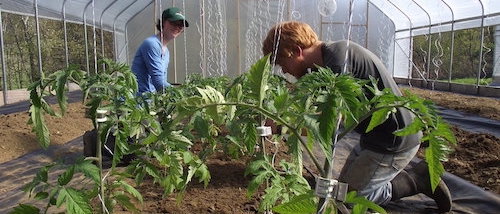From someone who went from skeptic to farmstand evangelist
In 2015 my dad and I built a farmstand on my farm, Nella Mae’s Farm in Cove, Oregon, from his “inventory” (aka lost and forgotten junk pile) accumulated during 30 years as a carpenter. I decided to build the farmstand at the urging of a farmer friend and mentor at Val’s Veggies who has a very successful farmstand in a neighboring county.
Val insisted a farmstand was the next step to my fledgling produce business; it was a way I could sell every day instead of just two farmers market days a week. I was very skeptical. What about theft and vandalism? I had read farmstand horror stories like this on farm message boards:
“At the farmstand theft was a big problem. Vandalism was a big problem. In the wintertime teenagers would break in and use the stand for lover’s lane. Broken wine and beer bottles. I remember at least twice Uncle Rodney had to go out and physically throw people out who decided to start living in the stand in the winter.” The author, ironically named Smiles Jr., goes on to say: “But the clincher was when Aunt Mildred was held up at gunpoint. She gave the perps all of the day’s income. When WalMart moved to town, Uncle Rodney burned the stand down.”
I was more amused than alarmed by this post, but I did have other doubts. I live on the outskirts of Cove, population 600, which doesn’t have a grocery store. The farm is a 30-minute drive from “town” — the small, but larger city where our farmers market is held. I just didn’t think my tiny community could or would support a farmstand. Cove-ites work and shop in town. Would a fraction of the 600 people the farmstand might attract really make it worth it?
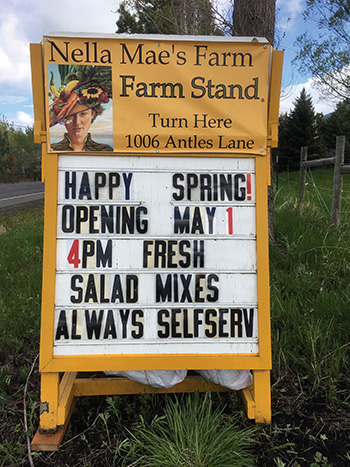 Nella Mae’s Farmstand sign.
Nella Mae’s Farmstand sign.
Furthermore, I knew I didn’t have time or energy to run a retail outlet on top of everything else I had to do. I told Val I was certain a farmstand wouldn’t work, but I would give it a try. I could always turn the building into a toolshed — that or burn it down like Uncle Rodney.
Now, after five years in the farmstand business, I can confirm Val was right, I was wrong. The farmstand has become one of the most successful and meaningful parts of our farm. I have become a farmstand evangelist and have helped several other folks start successful stands. I really believe in the power of farmstands to serve food-desert communities like mine and diversify and increase income for farms.
During the last year of the pandemic, the farmstand allowed me to feed many more neighbors, and our sales increased from about $7,000 per year to $27,000 as people stayed closer to home. I am more of a farmstand booster than ever, so I want to share what I’ve learned to help others.
Nella Mae’s Farmstand is an 8-foot by 12-foot building with two fridges, some shelves, a notebook for recording purchases and a money box. We have a coin bowl for change, we accept Venmo, CashApp, checks and food vouchers (the USDA allows federal food assistance SNAP to be spent at farms). Folks can track their cash balance on a note card if they only have big bills or want to pay ahead.
In the beginning, it was uninsulated, the studs and nails were showing, and we had to use a 300-foot extension cord specially made by the electrical shop in town to get electricity to the building. It started off clean, functional and rough. We now have power, lights, paint on the walls, insulation and parking.
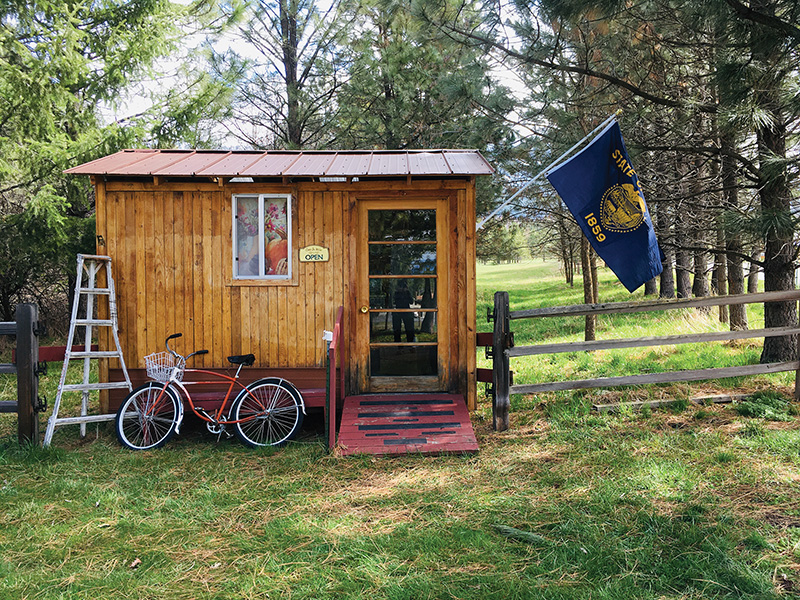 Nella Mae’s Farmstand in 2020.
Nella Mae’s Farmstand in 2020.
During the first few years, it took a lot of training and encouragement of neighbors and customers. I got a lot of notes and calls saying, “No one was in the stand, so I didn’t want to take anything.” After a couple of years of slow growth, the farmstand model is fully integrated into the community. People tell me they feel honored by the honor system. I’ve heard many variations of one customer’s comment: “I am so glad you trust us and that this is working for you. It gives me a lot of hope.”
I typically check and restock the stand at the end of my driveway once a day and collect money from the lockbox. During the pandemic, I was restocking two to three times a day and still getting calls from friends that the money box was too full to pay into and the shelves were bare.
During the pandemic, I also added a community food pantry to one side of the stand. It allowed folks to take what they needed, avoid trips to town, and share what they had — including books, games, homemade masks, and more. I feel 2020 really allowed the farmstand to meet its full potential to feed my community and support the farm.
Farmstand advantages
• New customers — Farmstands attract different and new customers and serve a new area. Not everyone has the energy or interest to go to a farmers market.
• Control — You set prices, hours, presentation and more. You also don’t have to apply to be in your own farmstand as you might for a farmers market.
• Increased sales — More days and outlets for sales.
• Fewer rules — On-farm farmstands (at least in Oregon) have fewer rules than sales to restaurants or retailers.
• Flexibility — You can sell extras from the market, unexpected bounties, and even those things you don’t have enough of for the market.
• Low costs — Low startup and maintenance costs.
• Save time — It takes less time to sell from a farmstand than at the farmers market.
• Community service and goodwill — People love farmstands. You can also increase economic activity and create jobs (if you hire people to staff it) which your community may really need.
• Off-season uses — My daughter says it’s a great winter club house.
Disadvantages
• Privacy — An on-farm farmstand does decrease your personal and operational privacy.
• Safety — When you invite folks onto your farm, you have to have a higher standard for keeping things safe for them and you.
• Customer service — You will see a lot more customers more of the time and have to be in customer-service mode.
• Farm operations — Folks stop by a lot more to see the farm and ask questions, which interrupts your work.
• Accounting — It is very difficult to do accurate accounting for sales in the self-serve farmstand. We have a notebook where folks write down their purchases, but it isn’t terribly accurate. If you are stressed out by not having perfect sales information, self-serve might not be a good fit.
Other farmstands may have encountered other disadvantages, but these are the primary downsides from our experience.
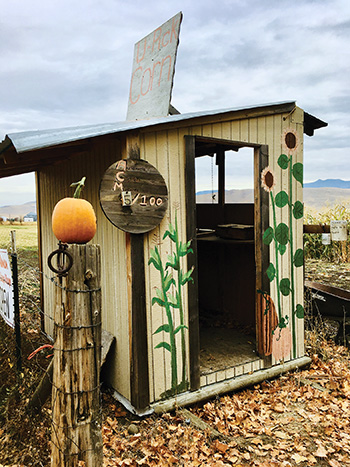 Automatc Corn Machine.
Automatc Corn Machine.
Farmstand models
I think it is important to model your farmstand to meet your goals, location, time, community needs, personality and personal boundaries. Our farmstand is on-farm because we live right on the edge of a small town with lots of access to local customers and self-serve because I have a limited amount of energy for one-on-one customer service.
Our farmstand is at the road on the other side of our tree line from our farm and house because I am fairly private. I close the gates when I don’t want unexpected visitors; when they’re open, folks are welcome to stop by. Other farmer friends have set up their farmstands differently based on their goals and situation. As I see it, farmstands break down into several categories.
Destination versus Daily Bread: Do you want your farmstand to be a visitor destination, a local grocery store or a little of both? I live on a state highway that basically ends at my town. There are few visitors, so my focus and personal ethic is about feeding my local people.
Self-serve versus staffed: Farm marketing folks advise that you can sell more if your farmstand or farm store is staffed. Staff can help customers, make change, develop relationships, run a SNAP/EBT machine and introduce new products. At our farmstand we are able to sell as much as we have without staff and have virtually no theft, so self-serve works for us.
Always open versus scheduled: Farm marketing folks also say that you can make more money with scheduled hours rather than being open 24/7 like our stand. In my community, virtually everyone who is not retired works in town, so I have found the “always open” model works best for my customers and my farm’s mission.
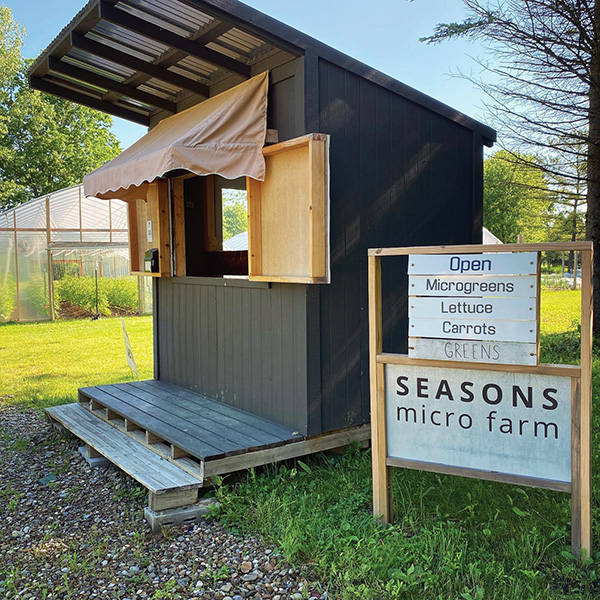 Seasons Micro-Farm stand.
Seasons Micro-Farm stand.
On-farm versus off-farm: Our farm is right on the city limits, just off the highway, so it is a great location for catching all the retired daily walkers as well as folks driving home from work. Not every farm is close enough to a customer base to have an on-farm farmstand, however, distance is not necessarily a barrier. Oregon’s Champoeg Creamery farm store attracts Portlanders from 45 minutes away for meat and milk without issue. However, for folks who don’t live close to a foody urban area, an off-farm farmstand might be a better fit.
Farmstand sampler
Val’s Veggies Farmstand: Val’s Veggies is a produce farm about 30 minutes from Baker City, Oregon, a town of 10,000. Val’s sets up their off-farm farmstand across from the city park in a gravel parking lot. They have a moveable building that they take home in the winter. The stand is staffed Sunday through Friday from 10 a.m. to 6 p.m. and they make do without electricity. Val’s also sells a lot of fruit from other local growers as well as salad from my farm. The stand also serves as a pick-up point for CSA shares.
Seasons Micro-Farm, Kent, Ohio: My friends Sarah Ketchum and Peter Johnson of Seasons Micro-Farm have a self-serve, on-farm farmstand with scheduled hours. This allows them to ensure the stand is always full, produce is freshly picked, and they have some privacy. They live on the edge of a neighborhood that is the primary customer base for their farmstand and CSA.
Platz Family Farm, Union, Oregon: The Platz family sells their produce primarily through their staffed, on-farm farmstand which is open Mondays, Wednesdays, Fridays and Saturdays from 10 a.m. to 6 p.m. They also have U-pick opportunities during the farmstand hours and it serves as a CSA pick up point. Their farmstand is a converted garage next to their house and adjacent to their fields. They are located on the edge of town, just off the state highway, with lots of access to customers in their town of 2,000 people. Their place is always hopping with customers.
Liza Jane’s Farmstand, Enterprise, Oregon: Our farmstand is modeled on Liza Jane’s Farmstand in neighboring Wallowa County. Liza Jane Nichols sells her 6 Ranch grass-fed beef as well as produce, honey, eggs and baked goods. Liza Jane’s has experienced almost no theft, so I figured if she could sell higher-dollar grass-fed beef right off a busy tourist highway without problems, I could sling some vegetables to my neighbors on the honor system.
U-Pick and seasonal farmstands: Near my house is a U-Pick corn and pumpkin patch. The folks who own it open the gate when the corn is ready and close it when the pumpkins are done. I am delighted every time I see the ACM, “Automatic Corn Machine” sign for the wooden payment box. I also love the seasonal pumpkin farmstand I saw on Vashon Island, Washington. A cooler, a tarp, and a few shelves to sell some extra pumpkins and squash.
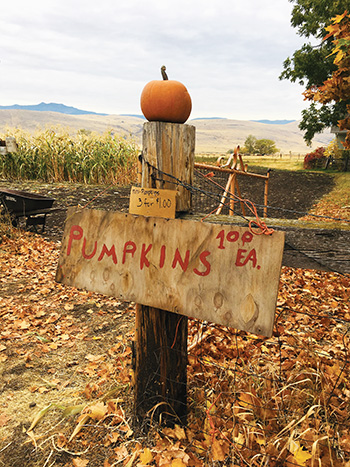 U-pick pumpkin patch.
U-pick pumpkin patch.
For anyone thinking about starting a farmstand, here are a few tips from my experience and community.
• Know your purpose, community, and customers. How can you serve the folks in your community? What new customers can you reach? What is your niche or advantage? Living in a food desert sadly means I don’t have any grocery store competition. It also means I can have a greater impact.
• Understand your personal boundaries. What do you need to do to have enough safety, privacy, and space from your on-farm farmstand? Gates, tree lines, distance, or scheduled hours?
• Visit other farmstands. What model do you like? What is appealing or unappealing? How do others’ systems work?
• Find out what you can sell. Do the rules in your state allow you to sell things you don’t grow or make from other farms?
• Check with the roads department. You need parking, a turn-in, and signage, so what is allowed? What is the safest design for traffic flow?
• Check with your county health department and agriculture department. In Oregon, we don’t need a permit for on-farm farmstands, but that isn’t the case everywhere. An off-farm farmstand is a whole different situation.
• Know your location’s zoning rules and restrictions. Some states make on-farm farmstands a “use by right” on farms, but this isn’t the case everywhere. They also might have rules about building your stand to code. Check with your county land use department.
• Talk to your insurance agent. Our farmstand was easily rolled into our farm policy and wasn’t expensive to cover. It wasn’t worth the money to insure the building for us, but liability insurance is important if the public is at your farm.
• Talk to the neighbors. Your farmstand could be a convenient grocery store or a horrible nuisance to your neighbors. I have worked hard to limit the traffic impact on my neighbors and grease the wheels of good will with lots of produce. My neighbors are my biggest supporters and vigilant watchers of the stand, which they all call “the vegetable shack.” They train newbies they meet at the stand and let me know when I’m out of beets or the fridge is on the fritz.
• Think about customer expectations and presentation. Curb appeal on the outside and a clean, well-organized setup with clear prices on the inside are important. Customers expect that you grew the produce, so if you are able to sell others’ products, make it clear.
Farmstands are a great option for many farms to diversify and increase income and better serve their local community. I started as an utter skeptic and now feel tenderhearted towards my farmstand and the way it feeds my local people and brings us together. On purely economic terms, it is an efficient, low-cost way to make money. The way the pandemic forced us to say home, slow down, and change habits last year will continue to make farmstands a popular option for buying local food.
More tips on starting a farmstand are available at www.nellamaesfarm.com.

